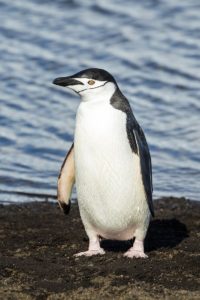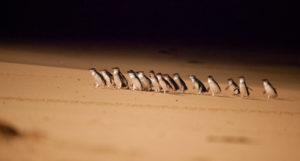Who are the comedic stars of the bird world? Penguins, of course! Stars of the big screens, they wear tuxedos, wobble when they walk, and their feathers stick out of their heads like clowns. Today is a good day to think about penguins—Penguin Appreciation Day!
The origin of Penguin Appreciation Day is lost in history, but that hasn’t slowed down the message: Penguins may be adorable but they are also fascinating examples of adaptation to harsh environments. So, here’s some information to help you appreciate them more.
All penguins live in the southern hemisphere. Galapagos Penguins push that definition, living basically on the Equator. At the tip of the globe, Emperor Penguins live deep in Antarctica, braving temperatures that can fall as low as -40 degrees Centigrade. Penguins live everywhere in between these extremes and on all the continents of the southern oceans, including South America, Africa and Australia.

The number of penguin species is up for debate among scientists, but 16-19 species is the usual range, distributed among 6 genera. As more DNA evidence comes in, some species get combined, others get split apart. At the moment, a big question is whether the Royal Penguin is just a differently colored Macaroni Penguin. And perhaps the Rockhopper Penguin is actually two or more species.
The largest is the Emperor Penguin, checking in at more than 40 inches tall and weighing as much as 80 pounds. At the opposite end is the Little Penguin (also known as the Fairy Penguin), weighing less than 3 pounds and standing a diminutive 13 inches tall.
The most common penguin is the Macaroni species, distributed on islands throughout the southern oceans. More than 11 million Macaroni Penguins exist. The least common is the Galapagos Penguin—only a few thousand exist, and they are endangered, just as most other species are that live in the Galapagos Archipelago.
Today, all penguins are protected by the Antarctic Treaty, first signed in 1959. The treaty prohibits harming penguins in any way, including hunting or collecting eggs. Collection for scientific or conservation purposes is allowed only by special permit(learn more about the treaty here).
Penguins are fundamentally aquatic animals. They spend most of their time in the water, feeding on invertebrates and small fish. They generally stay near the surface, where their food also lives. Their dives are typically short, no more than a minute or two. Penguins come ashore to molt and to reproduce, nesting on land or ice, often in large colonies.

They are expert swimmers, using their adapted wings as flippers to “fly” through the water. Adele Penguins are the sprinters of the clan, reaching speeds of 20 miles per hour. Unlike most birds, which have hollow bones that make flying easier, penguins have solid bones, which reduce their buoyancy and make diving easier.
But most of all, they are just plain cute!
References:
Penguinworld (website). Available at: http://www.penguinworld.com/index.php. Accessed January 19, 2017.
SeaWorld Parks and Entertainment. Animal information: Penguin. Available at: https://seaworld.org/en/animal-info/animal-infobooks/penguin. Accessed January 19, 2017.
